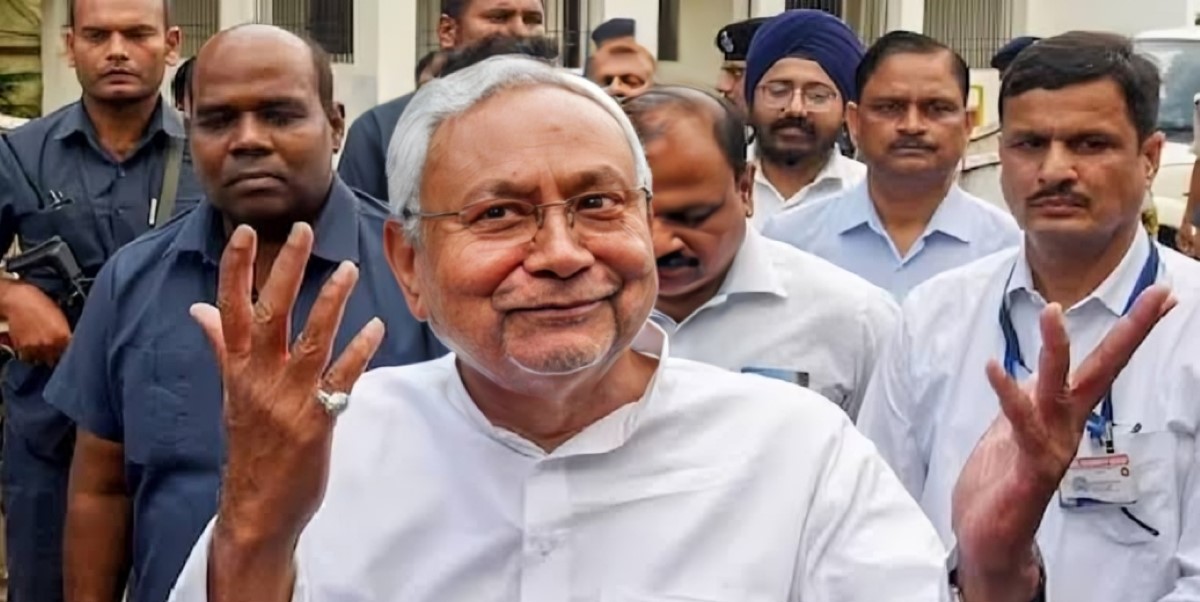By forenoon itself, it was clear that the voters in Bihar had opted to gift Nitish Kumar's experience yet another chance, sidelining the relative youthfulness of Tejashwi Yadav.
Published Nov 14, 2025 | 5:16 PM ⚊ Updated Nov 14, 2025 | 9:14 PM

Bihar Chief Minister Nitish Kumar. (X)
Synopsis: The trend showed that the people of Bihar have overwhelmingly rejected the issues the Opposition INDIA bloc had raised before the elections. The issues included the Special Intensive Revision of the electoral rolls, and a manipulation of voters’ list to favour the NDA.
The National Democratic Alliance (NDA) is set to retain Bihar with over 190 seats as the counting of votes of the two-phase polling completed 16 of the 30 rounds on Friday, 14 November.
Led by Chief Minister Nitish Kumar, the NDA seems to be heading for a massive sweep of the state, with the alliance leading in several seats. The Opposition Mahagathbandhan, meanwhile, is watching Raghopur closely, where its leader, Tejashwi Yadav trailed by over 9,000 votes at one point, but later romped home.
However, tn Mahua, Tejashwi’s elder brother Tej Pratap Yadav lost.
NDA workers in Patna and elsewhere in the state started celebrating before noon itself as the trend started trickling in. BJP workers at the party headquarters, too, went into a celebratory mode, as the high-stakes election to Bihar’s 243-member assembly was also seen as a validation of Prime Minister Narendra Modi’s rule of the nation.
By forenoon itself, it was clear that the voters in Bihar had opted to gift Nitish Kumar’s experience yet another chance, sidelining the relative youthfulness of Tejashwi Yadav.
At 3.30 pm, the BJP was leading in 94 seats, and the JDU in 84, putting the alliance comfortably ahead of its alliance. The RJD was leading in 25 seats, and the Congress in just two of the 61 seats it had contested.
The trend showed that the people of Bihar have overwhelmingly rejected the issues the Opposition INDIA bloc had raised before the elections. The issues included the Special Intensive Revision of the electoral rolls, and a manipulation of voters’ list to favour the NDA.
Exit polls on 11 November have predicted an NDA win, but all failed to read the signs of a sweep.
Even after 20 years in power, anti-incumbency di not erode Nitish Kumar’s base. Apparently, it has been neutralised—largely by the blessings of Bihar’s women.
Women, in fact, have emerged as the silent architects of this victory. Nitish Kumar has long understood the power of the female electorate.
In 2007, he gifted bicycles to schoolgirls, transforming mobility and aspiration. In 2016, he banned liquor, earning the gratitude of households across castes. And now, in 2025, his government transferred ₹10,000 directly into the accounts of one crore 25 lakh women under the Mahila Rozgar Yojana—a bold, costly move that has paid rich political dividends.
This financial empowerment scheme arrived just before the polls, a masterstroke that blunted criticism of fiscal strain and reinforced Nitish Kumar’s image as a leader who delivers. Even as sitting MLAs faced accusations of neglect and corruption, the women of Bihar seemed to have looked past the flaws and rewarded the man who had consistently placed their dignity and security at the center of his agenda.
Additionally, NDA forged a broad coalition, dominating among the upper castes, Scheduled Castes, Scheduled Tribes, and Extremely Backward Classes. Brahmins, Rajputs, Bhumihars, Kurmis, Kushwahas, Paswans, Chamars, Mallas, Telis, Banias, Kanus, and Nonias—all have tilted decisively toward the alliance.
The Mahagathbandhan, by contrast, focused more on Yadavs, Muslims, and select OBC pockets.
The opposition’s campaign revolved around unemployment and migration—issues. Tejashwi Yadav, once the youthful face of hope in 2020, tried to reignite that spark. But it seemed to have failed. The craze that once surrounded him among the youth has dissipated, siphoned off by Prashant Kishor’s Jan Suraj and even the BJP’s development narrative.
Unemployment persists, migration continues, but discontent did not coalesce into a unified anti-NDA wave.
Tejashwi Yadav’s challenges were compounded by the long shadow of “Jungle Raj.” The lawlessness and Yadav dominance associated with his father Lalu Prasad Yadav’s rule, seemed to have remained etched in the collective memory of Dalits and upper castes.
Prime Minister Narendra Modi directed sharper barbs at Lalu than at Tejashwi, turning “Jungle Raj” into the NDA’s most potent weapon. While the Mahagathbandhan spoke of jobs and exodus, the NDA countered with stability, progress, and the spectre of a chaotic past.
